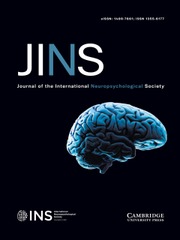Article contents
Discrepancy-Based Evidence for Loss of Thinking Abilities (DELTA): Development and Validation of a Novel Approach to Identifying Cognitive Changes
Published online by Cambridge University Press: 11 December 2019
Abstract
To develop and validate the Discrepancy-based Evidence for Loss of Thinking Abilities (DELTA) score. The DELTA score characterizes the strength of evidence for cognitive decline on a continuous spectrum using well-established psychometric principles for improving detection of cognitive changes.
DELTA score development used neuropsychological test scores from the Alzheimer’s Disease Neuroimaging Initiative (ADNI) cohort (two tests each from Memory, Executive Function, and Language domains). We derived regression-based normative reference scores using age, gender, years of education, and word-reading ability from robust cognitively normal ADNI participants. Discrepancies between predicted and observed scores were used for calculating the DELTA score (range 0–15). We validated DELTA scores primarily against longitudinal Clinical Dementia Rating-Sum of Boxes (CDR-SOB) and Functional Activities Questionnaire (FAQ) scores (baseline assessment through Year 3) using linear mixed models and secondarily against cross-sectional Alzheimer’s biomarkers.
There were 1359 ADNI participants with calculable baseline DELTA scores (age 73.7 ± 7.1 years, 55.4% female, 100% white/Caucasian). Higher baseline DELTA scores (stronger evidence of cognitive decline) predicted higher baseline CDR-SOB (ΔR2 = .318) and faster rates of CDR-SOB increase over time (ΔR2 = .209). Longitudinal changes in DELTA scores tracked closely and in the same direction as CDR-SOB scores (fixed and random effects of mean + mean-centered DELTA, ΔR2 > .7). Results were similar for FAQ scores. High DELTA scores predicted higher PET-Aβ SUVr (ρ = 324), higher CSF-pTau/CSF-Aβ ratio (ρ = .460), and demonstrated PPV > .9 for positive Alzheimer’s disease biomarker classification.
Data support initial development and validation of the DELTA score through its associations with longitudinal functional changes and Alzheimer’s biomarkers. We provide several considerations for future research and include an automated scoring program for clinical use.
Information
- Type
- Regular Research
- Information
- Journal of the International Neuropsychological Society , Volume 26 , Issue 5 , May 2020 , pp. 464 - 479
- Copyright
- Copyright © INS. Published by Cambridge University Press, 2019
Footnotes
Data used in preparation of this article were obtained from the Alzheimer’s Disease Neuroimaging Initiative (ADNI) database (adni.loni.usc.edu). As such, investigatorswithintheADNIcontributedtothedesignandimplementationofADNIand/orprovideddatabutdidnotparticipateinanalysisorwritingofthisreport. A complete listing of ADNI investigators can be found at: http://adni.loni.usc.edu/wp-content/uploads/how_to_apply/ADNI_Acknowledgement_List.pdf.
References
REFERENCES
An addendum has been issued for this article:
This correction applies to the following article(s):
- 5
- Cited by
Linked content
Please note an has been issued for this article.

